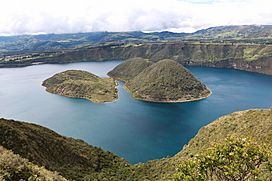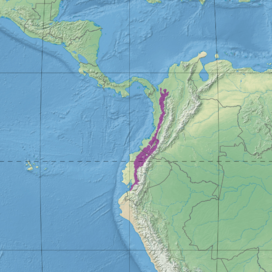Northwestern Andean montane forests facts for kids
Quick facts for kids Northwestern Andean montane forests (NT0145) |
|
|---|---|

Caldera of Cuicocha in the Cotacachi-Cayapas Ecological Reserve, Écuador
|
|

Ecoregion territory (in purple)
|
|
| Ecology | |
| Realm | Neotropical |
| Biome | Tropical and subtropical moist broadleaf forests |
| Borders |
List
|
| Geography | |
| Area | 81,325 km2 (31,400 sq mi) |
| Countries | Colombia, Ecuador |
| Coordinates | 0°55′44″N 78°07′23″W / 0.929°N 78.123°W |
| Climate type | Af: equatorial; fully humid |
| Conservation | |
| Conservation status | Vulnerable |
| Global 200 | Northern Andean Montane Forests |
| Protected | 15.025% |
The Northwestern Andean montane forests (NT0145) is a special natural area. It's found high up in the Andes mountains, in parts of Colombia and Ecuador. This ecoregion is like a huge, green blanket covering the western side of these tall mountains. It's home to an amazing variety of plants and animals.
This area has a huge number of different species. This is partly because of past ice ages. During cold times, warmer areas became separated. During warmer times, cooler areas became separated. This led to many new species forming over time. People have lived here for a long time, even before Columbus. They have changed the land a lot for farming and raising animals.
Contents
Geography of the Andean Forests
Where are the Northwestern Andean Forests?
The Northwestern Andean montane forests ecoregion stretches along the western mountain ranges of the Andes. These are called the Cordillera Occidental in Colombia and Ecuador. This large area covers about 8.1 million hectares (about 20 million acres).
To the north, this ecoregion connects with the Magdalena–Urabá moist forests. Along most of its length in Colombia, it meets the Chocó–Darién moist forests to the west. To the east, it borders the Cauca Valley montane forests. Higher up, the ecoregion changes into the Northern Andean páramo, which are high-altitude grasslands.
In the middle, it almost completely surrounds the Patía Valley dry forests. In its southern part, it connects with the Western Ecuador moist forests to the west. To the east, it meets the Eastern Cordillera Real montane forests. The very southern tip of this ecoregion touches the Tumbes–Piura dry forests.
Mountain Terrain and Landscape
This ecoregion covers the western side of the Andes mountains. It includes a wide range of elevations, from lower slopes to isolated peaks. This varied landscape creates many different types of habitats.
Climate of the Montane Forests
The climate here is humid and tropical. This is because the ecoregion is located within the Inter-Tropical Convergence Zone. This zone is where winds from the Northern and Southern Hemispheres meet.
Rainfall is usually between 2,000 and 4,000 millimeters (79 to 157 inches) per year. However, at higher altitudes, it can drop to 1,000 to 2,000 millimeters (39 to 79 inches). The average temperature is around 25 to 26 degrees Celsius (77 to 79 degrees Fahrenheit) throughout the year.
Ecology and Biodiversity
The Northwestern Andean montane forests are part of the Neotropical realm. This is one of the Earth's major land areas based on its animal and plant life. It belongs to the tropical and subtropical moist broadleaf forests biome. This means it's a warm, wet forest with many broad-leaved trees. It's also part of a larger group called the Northern Andean Montane Forests.
How Ice Ages Shaped Life
During cold periods, like ice ages, plants and animals that liked warmer climates became trapped in small, separate areas. At the same time, cooler zones grew larger and connected. When the climate warmed up again, the warmer zones expanded and reconnected. The cooler zones then became isolated. This constant change helped create many new species. This is why the region has such high levels of both diversity (many different kinds of life) and endemism (species found nowhere else).
Flora: Plants of the Andean Forests
Scientists have studied the plants in this ecoregion a lot. It's one of the most studied plant areas in South America. About half of all the plants found here grow nowhere else in the world. This means they are strictly endemic.
The variety of flowering plants is incredible. You can find as many as 300 different species in just one hectare (about 2.5 acres)! Different plant groups grow at different heights on the mountains. Generally, the number of species goes down as you go higher up.
- Premontane Forests: These grow between about 1,000 and 2,000 meters (3,300 to 6,600 feet) high.
- Lower Montane Forests: These are found from about 2,000 to 2,800 meters (6,600 to 9,200 feet). These forests are also called sub-Andean forests. Their tree canopy (the top layer of leaves) can be 25 meters (82 feet) tall or more. The canopy usually gets shorter as you go higher.
- Upper Montane Forests: These forests grow from 2,800 up to 4,000 meters (9,200 to 13,100 feet) high. They are also known as elfin forests or cloud forests. Their canopy is shorter, about 15 to 20 meters (49 to 66 feet) tall. These forests are full of epiphytes (plants that grow on other plants, like air plants). They also have many unique mosses, ferns, aroids, bromeliads, melastomes, and orchids.
This ecoregion is home to Quercus humboldtii, which is South America's only native oak tree. You can also find Trigonobalanus excelsa, an oak relative whose closest family members live far away in Southeast Asia. The Colombian walnut (Juglans neotropica) also grows here.
Fauna: Animals of the Andean Forests
The Northwestern Andean montane forests are home to many amazing animals, including several endangered species.
Mammals of the Andean Forests
Some endangered mammals living here include:
- Baird's tapir (Tapirus bairdii)
- Black-headed spider monkey (Ateles fusciceps)
- Cotton-top tamarin (Saguinus oedipus)
- Mountain tapir (Tapirus pinchaque)
Other native mammals you might find are the northern pudu (Pudu mephistophiles), which is a small deer, and the powerful jaguar (Panthera onca).
Birds of the Andean Forests
This ecoregion has many birds that are found nowhere else. Some endangered bird species include:
- Black-and-chestnut eagle (Spizaetus isidori)
- Black-breasted puffleg (Eriocnemis nigrivestis)
- El Oro parakeet (Pyrrhura orcesi)
- Yellow-eared parrot (Ognorhynchus icterotis)
Reptiles and Amphibians
Some endangered reptiles found here are the Western Ground Snake (Atractus occidentalis) and the Tropical Lightbulb Lizard (Riama oculata).
The ecoregion is also home to many endangered amphibians, especially frogs and toads. These include various types of:
- Atelopus stubfoot toads
- Centrolene glass frogs (which have see-through skin!)
- Pristimantis rain frogs, also known as robber frogs
Other endangered frogs include the Carchi Andes toad (Rhaebo colomai) and the Lehmann's poison frog (Oophaga lehmanni).
Conservation Status
The World Wide Fund for Nature (WWF) says this region is "Vulnerable." This means it's at risk and needs protection.
People have lived in this area for a very long time, even before Columbus arrived. They have used the land for farming and raising animals. Because of this, much of the natural environment has been changed. However, there are still some large areas of continuous forest left.
About 15% of the ecoregion is protected. These protected areas include several national parks, such as:
- Cayambe Coca National Park
- Sangay National Park
- Cotopaxi National Park
- Cajas National Park
- Farallones de Cali National Natural Park
- Las Orquídeas National Natural Park
- Munchique National Natural Park
- Paramillo National Natural Park
- Purace National Natural Park
- Tatamá National Natural Park
Sources
See also
 In Spanish: Bosques montanos del noroeste de los Andes para niños
In Spanish: Bosques montanos del noroeste de los Andes para niños

